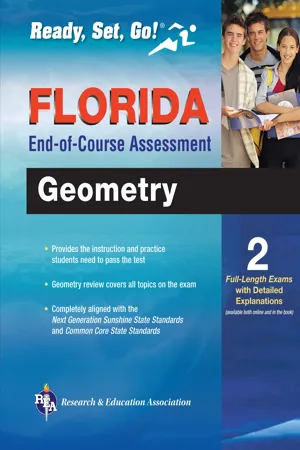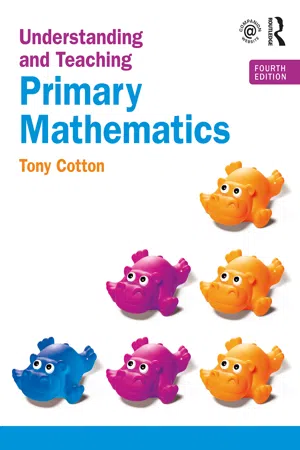Equilateral Triangles
Equilateral triangles are a type of triangle where all three sides are of equal length. Additionally, all three angles in an equilateral triangle are also equal, each measuring 60 degrees. This makes equilateral triangles a special case of both equiangular and equilateral polygons.
8 Key excerpts on "Equilateral Triangles"
- eBook - ePub
Dyslexia, Dyscalculia and Mathematics
A practical guide
- Anne Henderson(Author)
- 2013(Publication Date)
- Routledge(Publisher)
...scalene triangle with no equal sides or angles An isosceles triangle has two equal sides and two equal angles opposite them. Figure 9.12 Isosceles triangle An equilateral triangle has all sides of equal length and all angles of equal size (60°). Figure 9.13 Equilateral triangle Properties of shapes Squares ● Copy, cut out, stick onto card and turn the angle pictures and facts given into a memory card (number 20, see page 144). Four equal angles all 90° Four equal sides Opposite sides are parallel Figure 9.14 Properties of a square ● Explain that a 3D shape with square sides is a cube. Rectangles ● Copy, cut out, stick onto card and turn the angle pictures and facts given into a memory card (number 21, see page 144). Four equal angles all 90° Opposite sides equal Opposite sides parallel Figure 9.15 Properties of a rectangle ● Explain that a 3D shape with rectangular sides is a cuboid. Circles ● Copy, cut out, stick onto card and turn the angle pictures and facts given into a memory card (number 22, see page 144). ● Use colour to show...
- eBook - ePub
- Mel Friedman(Author)
- 2012(Publication Date)
- Research & Education Association(Publisher)
...CHAPTER 6 Geometry Topics CHAPTER 6 GEOMETRY TOPICS Plane geometry refers to two-dimensional shapes (that is, shapes that can be drawn on a sheet of paper), such as triangles, parallelograms, trapezoids, and circles. Three-dimensional objects (that is, shapes with depth) are the subjects of solid geometry. TRIANGLES A closed three-sided geometric figure is called a triangle. The points of the intersection of the sides of a triangle are called the vertices of the triangle. A side of a triangle is a line segment whose endpoints are the vertices of two angles of the triangle. The perimeter of a triangle is the sum of the measures of the sides of the triangle. An interior angle of a triangle is an angle formed by two sides and includes the third side within its collection of points. The sum of the measures of the interior angles of a triangle is 180°. A scalene triangle has no equal sides. An isosceles triangle has at least two equal sides. The third side is called the base of the triangle, and the base angles (the angles opposite the equal sides) are equal. An equilateral triangle has all three sides equal.. An equilateral triangle is also equiangular, with each angle equaling 60°. An acute triangle has three acute angles (less than 90°). An obtuse triangle has one obtuse angle (greater than 90°). A right triangle has a right angle. The side opposite the right angle in a right triangle is called the hypotenuse of the right triangle. The other two sides are called the legs (or arms) of the right triangle. By the Pythagorean Theorem, the lengths of the three sides of a right triangle are related by the formula c 2 = a 2 + b 2 where c is the hypotenuse and a and b are the other two sides (the legs). The Pythagorean Theorem is discussed in more detail in the next section. An altitude, or height, of a triangle is a line segment from a vertex of the triangle perpendicular to the opposite side...
- Sandra Rush(Author)
- 2013(Publication Date)
- Research & Education Association(Publisher)
...If you know one side and two angles in a triangle, the lengths of the other two sides are predetermined. Can you see above (right) that if we extend the two partial sides, they will meet at a point (let’s call it T) that depends on R and S ? Thus, there is one and only one triangle that can be drawn if you know the two angles and the distance between them. Again, finding the lengths of any of the two remaining sides requires a knowledge of trigonometry. Note that if all you know are the lengths of two sides of a triangle and nothing about the angles, you don’t automatically know the third side of the triangle—it actually could be anything, depending on what the angle between the two sides is. In the figures in this chapter, if sides are equal, they will be marked with the same tick marks (either one or two). Likewise, if angles are equal, they will be marked with the same angle mark. Right angles are marked with a small box. Types of Triangles Triangles can be classified by their side measurements. Scalene : A triangle in which the lengths of all of the sides are different. Isosceles: A triangle with two equal side lengths. The two equal sides are called the legs, and the third side is called the base. Equilateral : All three side lengths are equal. The name comes from the two parts of the word: equi (“equal”) and lateral (“sides”). An equilateral triangle is also called an equiangular triangle because, if all three sides are equal, so are all three angles. The two parts of the word equiangular are: equi (“equal”) and angular (“angle”). The angles in an equilateral triangle are each 60° because there are three of them and they have to add up to 180°. The sum of the lengths of any two sides of a triangle must be greater than the length of the longest side, or we don’t have a triangle (the two sides won’t meet)...
- eBook - ePub
- Gary Thorne(Author)
- 2015(Publication Date)
- Crowood(Publisher)
...An equilateral triangle has three sides equal and three angles equal, each being 60 degrees. A perpendicular line drawn from the vertex to the base of the triangle is termed the altitude. Inscribed circles within an equilateral triangle. To inscribe circles within an equilateral triangle: An equilateral triangle. 1. Establish an equilateral triangle. 2. Bisect sides BAC, ABC and ACB to achieve points D, E and F. 3. Bisect ADC to arrive at G. 4. Using compass or dividers measure off AG and plot this measurement from B and then from C to establish the centre of the remaining two circles. Subdivision of a square. A square can be subdivided using diagonals, forming 90 degree angles, which can then be further subdivided. P ROPORTIONAL DIVISIONS Using a rule to make equal divisions. To divide a distance of any width into an equal number of units, using a rule: An example of a given distance to be divided into equal parts for establishing regular period panelling. A two stage approach for dividing planking into equal parts on a ledge or batten door. 1. With two parallel lines being the distance to be divided, place a rule diagonally across so that the zero end and its required division connect with the parallel lines. 2. Mark off the divisions as shown. 3. Draw a series of parallel lines as plotted through the divisions. Establishing tread proportions within a given distance. An example of establishing tread. proportions of equal units between a given distance for an open stringer staircase. An example of establishing tread and riser proportions between two given distances. Top view establishes the tread depth proportion between a given distance. Elevation view establishes the riser proportion between a given distance. Staircase detail depicting pitch, tread (going) dimension and riser (height). To establish step tread proportions within a given distance, the same technique applies...
- Rebecca Dayton(Author)
- 2013(Publication Date)
- Research & Education Association(Publisher)
...What must be the measure of the three angles? By definition, an isosceles right triangle has one right angle. Therefore, the measure of one angle is 90°. Since the triangle is also isosceles, it has two congruent sides. If a triangle has two congruent sides, it also has two congruent angles. The sum of the degrees in a triangle is 180°. With one angle measuring 90°, there are 90° remaining to be split evenly between the two remaining congruent angles. The three angles are 90°, 45°, and 45°. Example: Classify the given triangle by angle measure. Both angles given are acute. The third angle measures 80° because the sum of the degrees of a triangle is 180°. Since all three angles are acute, the triangle can be classified as acute. Definitions Related to Triangles An altitude of a triangle is a perpendicular segment from a vertex to its opposite side. Every triangle has three altitudes, which are also referred to as the height of the triangle. A median of a triangle is a line segment joining a vertex to the midpoint of its opposite side. Every triangle has three medians. An angle bisector in a triangle is a segment that is drawn from a vertex and cuts the angle in half. Every triangle has three angle bisectors. A perpendicular bisector of a triangle is a line that passes through the midpoint of a side and is perpendicular to that given side. Every triangle has three perpendicular bisectors. Points of Concurrency When three or more lines or segments intersect at the same point, the lines are called concurrent lines. The point at which concurrent lines intersect is called the point of concurrency. circumcenter of a triangle: the point of concurrency of the 3 perpendicular bisectors of a triangle. The circumcenter can be inside, on or outside the triangle. The circumcenter is equidistant from the vertices of a triangle. incenter of a triangle: the point of concurrency of the 3 angle bisectors of a triangle...
- eBook - ePub
- Andrew Davis, Maria Goulding, Jennifer Suggate(Authors)
- 2017(Publication Date)
- Routledge(Publisher)
...They have to appreciate that this is so because they are both closed shapes with three straight sides, or even because they are both ways of joining three points by straight lines. They need to move away from thinking of shapes only as wholes, and to learn to consider the properties or parts of shapes. b We are not always clear whether shape definitions are inclusive or exclusive. For instance, most of us remember that isosceles triangles have two equal sides (Figure 17.5). Figure 17.5 We may be much less clear about whether to call Equilateral Triangles special kinds of isosceles triangles. Do isosceles triangles have two and only two equal sides? Or do they have not less than two equal sides? The former definition is ‘exclusive’ while the latter is ‘inclusive’. To add to the difficulty, mathematical dictionaries or other sources of ‘official’ definitions do not always agree with each other about the inclusive/exclusive issue, or indeed about other matters. We will note examples shortly. Ultimately none of this is of any particular mathematical significance. What is important is that teachers work with a clear definition that is reasonably close to normal mathematical usage, and that they help children to understand that definition. It is a matter of convention, and convention is occasionally not as clear as it might be. c Shape terms vary enormously in specificity. A shape may belong to a number of families. For instance, ‘square’ is a highly specific term for a shape with four equal sides and four right angles, whereas ‘quadrilateral’ is a very general term covering any polygon with four straight sides. Hence all squares are quadrilaterals, but not all quadrilaterals are squares. ‘Side’, ‘edge’, ‘face’, ‘corner’ and ‘vertex’ I want to suggest a consistent usage of ‘side’, ‘edge’, ‘face’ (surface), ‘corner’ and ‘vertex’ (‘vertices' plural). There is nothing absolute about the suggestion, and it is not enshrined in ‘official’ mathematics. Here it is...
- eBook - ePub
- Tony Cotton(Author)
- 2020(Publication Date)
- Routledge(Publisher)
...The best way to explore line symmetry is through folding shapes. If you can fold the shape in half so that the pieces fit exactly on top of each other, you have found a line of symmetry. For example: A shape can also be described as having rotational symmetry. This means that you can rotate the shape and it will look the same before you have rotated the shape through 360 degrees. The order of rotational symmetry is the number of times the shape is repeated before it makes a complete turn, and the degree of rotational symmetry is the amount of turn you must make for a repeat to take place. Portfolio task 9.4 Draw the regular polygons given in the table on page 200. Find all the lines of symmetry for each shape. What do you notice about the result? Why do you think this is the case? Teaching points Teaching point 1: issues with language – describing properties; positional language Find a couple of friends, or phone a couple of people up. Ask them to find a scrap piece of paper and draw a triangle. My prediction would be that they draw an equilateral triangle. I have tried this out with very large groups of students, teachers and children and this is always the case. Of course, there is a huge range of triangles to choose from (isosceles, scalene, right-angled), but it appears as though the default option is equilateral. Indeed, many young children find it difficult to see a shape like this as a triangle as it looks very different from the triangles that they have previously seen. This looks very different from the shape they were first introduced to as ‘triangle’. This takes us back to the discussion about generalisation earlier in the book. When introducing shapes to children, it is very important that they see the whole range of shapes. Rather than offering one example of a triangle, offer a whole range and ask children what all the shapes have in common...
- Fuchang Liu(Author)
- 2017(Publication Date)
- Routledge(Publisher)
...Children usually don’t have any difficulty distinguishing two categories of objects with one type having a name composed of the other plus a modifier. By the same token, if a square is referred to as an equilateral rectangle, it is as clear as equilateral triangle is. Children will easily perceive an equilateral rectangle as a subset of rectangles, and they will have no trouble understanding that an equilateral rectangle is still a rectangle. Second, it will be no longer necessary for teachers to spend much time explaining the relationship between these two terms—no more clichés like “All squares are rectangles but not all rectangles are squares.” Third, and most importantly, there will be no such mistakes as enumerating non-mutually exclusive things like “triangles, rectangles, squares, and hexagons.” When squares are referred to as equilateral rectangles, it will be as unlikely for teachers and their children to say “triangles, rectangles, and equilateral rectangles” as to say “Please take out a pencil, a marker, and a red marker.” Base Doesn’t Necessarily Mean “Side at Bottom” Jane drew a triangle on the board as indicated by Figure 10.6 and told her class, “In order to find the area of a triangle, we need to know its base and height. The base of a triangle is the side at the bottom. Let’s label it b. The height is the perpendicular distance between the base and its opposite vertex...







